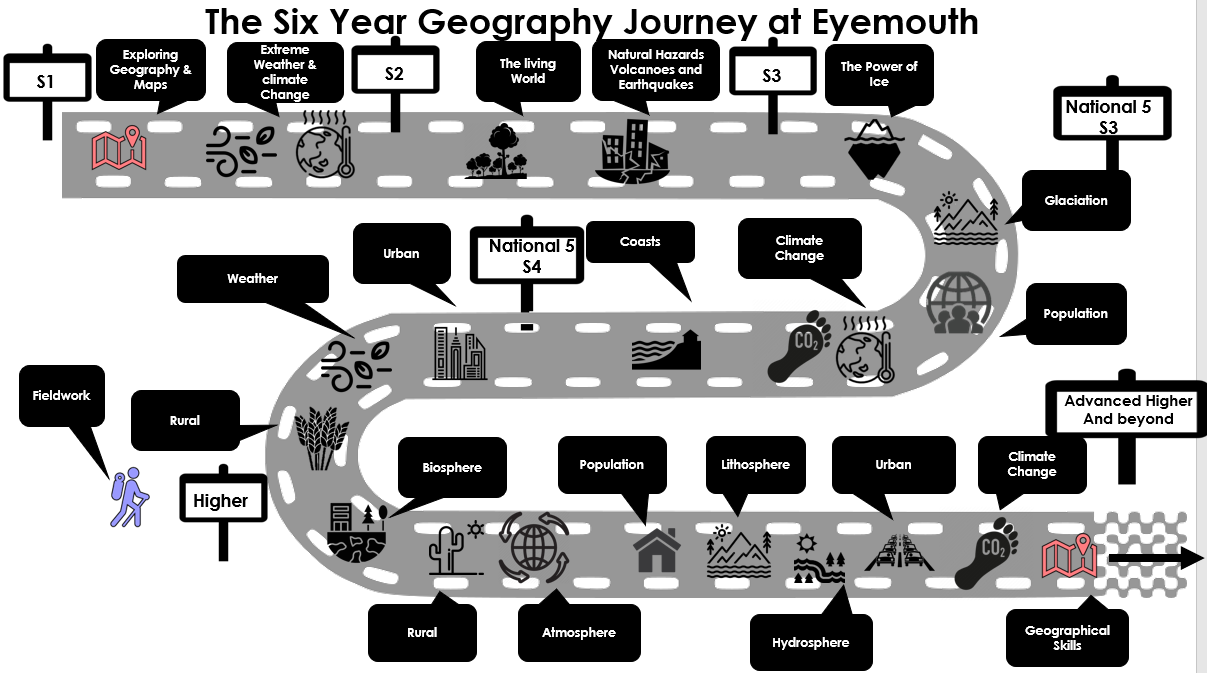Senior Phase (S4-6)

Why Study Geography?
Studying geography helps us to make sense of the world in which we live. Geography allows us to understand our environment, from helping us to predict weather, and climate changes to implementing and planning in response to global issues. Geography covers two keys areas looking at our physical world where we answer the questions on how landforms like mountains, rivers and coasts have been formed and then we look at the human world and how we have impacted our world through climate change, population structures, migration and farming.
The course provides geographical perspectives on important issues concerning the environment, sustainability and citizenship. They encourage fieldwork and the use of local environments and the acquisition of geographical skills.
National 4/5
The National 4/5 course supplies learners to learn more about the world in which we live, developing key skills in mapping, research skills, fieldwork and extracting and interpreting information.
The course has three core units, which are;
Physical Environments
Coastal Landforms - Learners learn how to visualise and interpret coastal land forms and the formation of erosional and depositional features including; Arch, Stack and Stumps, Headlands and Bays, Wave-Cut Platforms, Spits and Sandbars.
Glaciated Landforms - Learners then look back on our past ice ages that have formed the shapes of our mountain landscapes in Scotland. Learners will be able to analyse and explain the formations of U-Shaped Valleys, Corries, Aretes and Pyramidal Peaks. Learners then look at a case study on the Cairngorms National Park and explore how different groups of people use the glaciated uplands and the conflicts that differing land users come into.
Weather - Learners will study the differing factors that influences UK weather, the five air masses that dominate UK weather and learn how to interpret and analyse synoptic pressure charts.
Human Environments
Population - Learners will look at reasons why some countries are developed and other countries are developing by learning about differing factors of development. Leaners compare reasons for birth and death rates between developed and developing countries and look at the human and physical factors that impact world population densities.
Urban - learners will compare two world cities between a developed world case study and a developing world case study. Learners will investigate the problems and solutions to slum living in the Dharavi slum of Mumbia, India. Then look at the changes of Edinburgh's city centre, inner city and urban fringe. Learners then look at what factors influence companies' decisions to build in locations.
Rural - Learners explore changes to farming and the impacts of the changes to farming of both farmers in UK and India.
Global Issues
Climate Change - Learners explore the causes, impacts and solutions to Climate Change.
Health - Learners explore the causes, impacts and solutions to Malaria.
Assessment
National 5 Geography is assessed in two part;
- Component 1 - Exam making up 80% of the total mark.
- Component 2 - An assignment making up 20% of the total grade. (Assignment is completed in class time)
National 4 Geography Information
National 5 Geography Information
Higher
The Higher course supplies learners to learn more about the world in which we live, developing key skills in mapping, research skills, fieldwork and extracting and interpreting information.
The course has four core units, which are;
Physical Environments - (Paper 1 - 50 marks)
Lithosphere - Learners explore how the erosional and positional forces have shaped our lands by exploring Coastal and Glaciated formation features.
Hydrosphere - Learners will explore the factors that influence the hydrological cycle along with interpreting storms graphs and analysing human and physical factors that affect flooding events. Leaners will also explore how rivers shape our land and how humans interact with rivers.
Biosphere - Learners learn about the importance and characteristics of three soil groups, looking at a Brown Earth, Podzol and Gley.
Atmosphere - Learners explore factors for variations in solar energy between the poles and tropics, along with exploring the redistribution of energy between the atmosphere and oceans.
Human Environments - (Paper 1 - 50 marks)
Urban - Learners look at two case studies and compare the problems, solutions and effectiveness of solutions to housing and transport in Edinburgh and Rio De Janerio.
Rural - Learners explore the impacts and solutions to land degradation in the Shael and then explore how different land users are in conflict in the popular area of Dorset, England.
Population - Learners look at how countries can gather population data and then evaluate the difficulties of gathering accurate data. Learners explore the consequences countries will face with having both an ageing and young population. Learners then explore two migration case studies looking at voluntary and forced migration. Learners will be able to analyse the push and pull factors and impacts on host and donor countries.
Global Issues - (Paper 2 - 40 marks)
Climate Change - Learners will explore further the causes, impacts and solutions to climate change.
Development and Health - Learners explore the validity of using development indicators, and explore the causes, impacts and management of malaria.
Geographical Skills - (Paper 2 - 20 marks)
Pupils learn the skills in using map evidence and discussing suitability of sites for differing building scenarios and use map evidence to explain the social, economic and environmental impacts of the scenario.
Assessment
Higher Geography is assessed in two part;
- Component 1 - Exam making up 70% of the total grade
- Component 2 - An assignment making up 30% of the total grade. (Assignment is completed in class time)
